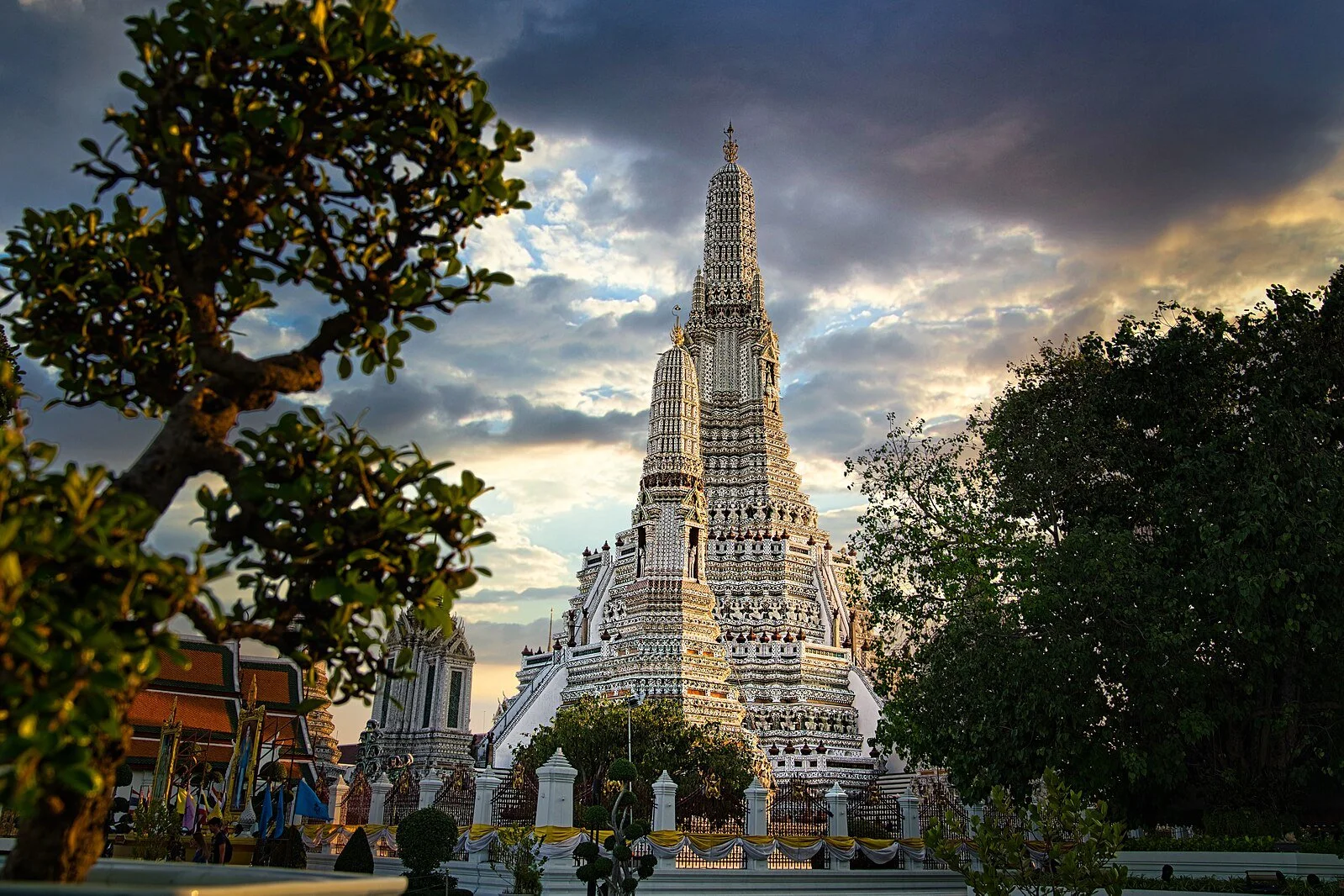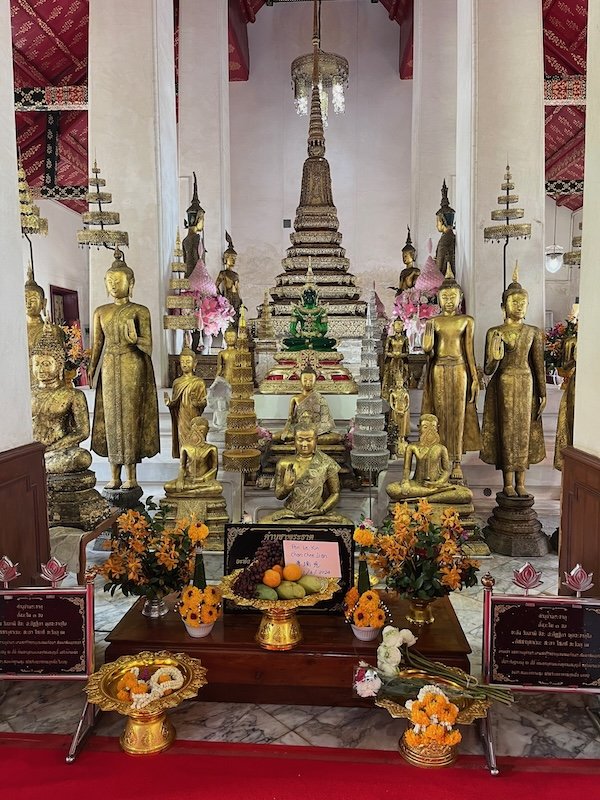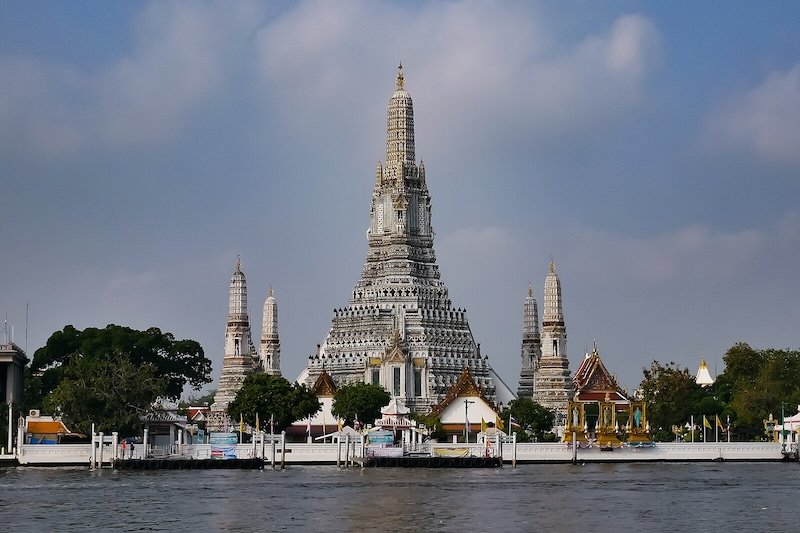Wat Arun: The Temple of the Dawn
Wikipedia Commons: Credit Jean-Pierre Grosset
PEARL: Chapter 10 ‘A Servant of Two Masters’
…A series of landing bridges loomed ahead, six exquisite Chinese pagodas of green granite, glistening like polished jade in the brilliant sunlight. The party disembarked and processed along a white marble pathway towards a complex of buildings ascending like a vision of a heavenly paradise. Four smaller towers girdled an identical but towering central prang, as tall at least as the main mast on a sailing ship. Carved in finely wrought lattice, in tier after tier of figures, flowers and patterns, the complex created a bewildering effect that appeared as delicate as lace, yet was sculpted of solid stone. Atop the soaring stupa stood a great seven-pronged spear of shimmering gold. Light stared in astonishment, his mouth gaping. He had never seen the like.
‘Magnificent, is it not?’ Lord Thian could scarce keep the pride from his voice, doubting that European cities had anything to rival the glory of Siam. He imagined these westerners came from dark, squat, ugly places, barren of the inspiration that came from knowledge of a higher existence.
‘Indeed, sir,’ Light gasped. ‘Is this the new palace of the king?’
Thian was amused. ‘This is Wat Chaeng, a temple complex. The palace stands in its grounds. But the temple is the focal point. For what are we but insignificant specks in the eye of the Buddha? Even a king must know his place.’
Not for the first time, Light was intrigued by the philosophical gulf that existed between west and east. In Europe, the purpose of great buildings – even those of religious significance – was to humble. Thian’s explanation suggested the opposite, that they were salient reminders to the powerful of their own feet of clay. Yet Light was not entirely convinced that Tak Sin’s construction projects were quite as noble in intent. ‘Did the king build this? In so short a time?’ Light wondered aloud.
‘There was a humble temple here before, Wat Makok. Our fledgling forces visited while we were struggling to drive the Burmese from Bangkok fort across the river. Dawn was breaking when the king led us to the temple where we prayed for many hours. King Tak Sin believes that this was the moment our victory was sealed. We returned to the battlefield and expelled the Burmese in an astonishing rout. Afterwards, the general vowed to rebuild the temple in splendour as a living embodiment of the new Siam arising from the ashes of disaster. It is now Wat Chaeng, the great Temple of the Dawn.’
Strolling around the complex, Lord Thian proved to be an eager and well-informed guide. He indicated the hundreds of statues arranged around the perimeter of the base, intricately sculpted figures of ancient warriors and mythical beasts. In recesses too many to count, golden Buddhas wrapped in yellow silk, stood silent and serene, contemplating the new city out of jewelled eyes. Climbing to the higher second terrace, the two men craned their necks and screwed their eyes up against the sun to observe the great statue of the God Indra, set inside a deep alcove far above, riding the three-headed Erawan, like a guardian at a gateway.
‘Each side contains a similar statue of the god on his three-headed elephant. He surveys the four directions of the kingdom, for Indra is the special deity of the kings of Siam.’
‘Indra is a Hindu god, is he not?’ Light asked, curious how a Hindu god had found a dwelling inside a Buddhist shrine.
Thian bowed his head in agreement. ‘All deities have their place in the cosmos. Lord Buddha sits serene at the centre, flanked by the fiery gods of the pantheon. See, at the very top of the stupa, the highest point of all?’ He pointed upwards to the soaring steeple, shaped like a trident with seven teeth. ‘That is the seven-pronged fork of Lord Siva. This great temple represents Mount Meru reborn, surrounded by the four towers of Phra Phai, the God of the Winds. There is much symbolism here. It harnesses the energies of the universe–’
‘–And creates awe in the hearts of all who observe it,’ Light answered, reflecting his own emotional response to the grand spectacle. Although he grasped little of the complex worldview of Buddhism, he understood the message, despite Thian’s alternative more altruistic argument. Great buildings were statements of power and authority the world over. Yet few were as beautiful as this…
One of the most popular of the many temples (wat) in Bangkok is surely Wat Arun, lying on the Thonburi side of the great Chaophrya River across from the Royal Palace and Wat Pho. In a city of beautiful temples, nothing can quite compare with the magnificence and aesthetic perfection of this creation of King Taksin, defeater of the Burmese and the founder of the original Thonburi capital across the river from Bangkok. Today it is usually thronged with tourists - go early if you want to see it in a more peaceful mood – and also many Thais of all ages who come splendidly attired in 18th century attire for a photo opportunity. This spectacle is almost as colourful and charming as the temple itself!
Beautiful Thai ladies in traditional 18th century dress
The story behind the Temple of Arun goes back to the mid 18th century. At that time, the capital of Siam was situated in the magnificent Ayutthaya further north, one of the greatest Asian cities of its day, with a population of around one million inhabitants - and many European traders settled in their own quarters of the city. But in 1765, disaster struck. A mighty Burmese army invaded from the north eventually laying siege to the capital which had always believed itself impregnable. It was months before the siege was finally broken and Ayutthaya fell in an orgy of destruction and enslavement for its people. It seemed as though Siam had finally been conquered by its traditional enemy, Burma.
Ayutthaya on the eve of the Burmese attack [National Museum of Bangkok]
One young general and scholar, Tak Sin escaped the devastation with a small company of soldiers and headed south to raise a new army against the Burmese. It was an ambitious plan but incredibly, he achieved his aim. By 1768 the two armies were ready to face each other at the final battle for the possession of Bangkok fort on the Chaophraya river. Early in the morning before sun up, Tak Sin led his officers and men to a small shrine then known as Wat Makok across the river at Thonburi. There they prayed for victory until the sun rose.
Praying at the temple before the battle
The ensuing battle – in which the Siamese forces were vastly outnumbered – was a great victory for Tak Sin and began the ultimate rout of the Burmese from Siamese territory. Tak Sin became the new king of Siam, taking the official name of King Borommoraja IV, although he is almost always referred to as Taksin Maharat (Taksin the Great). In his earlier life, Tak Sin had been a scholarly monk. He did not forget the small shrine where he and his men had prayed and the role it had played in their victory. After his enthronement, Tak Sin rebuilt Wat Makok into a magnificent temple complex in thanks for his incredible –and unlikely –triumph. He gave his new creation the name of Wat Chaeng (The Temple of the Dawn). He also built a number of palaces and temples within its grounds.
The Buddha in the Ordination Hall [credit: Wikipedia Commons. Christophe95]
The temple complex was originally also the site of the royal palace of King Tai Sin. Some of the subsidiary residences of the Uparaja (chief of the army) and the king’s sisters can still be visited in the grounds. The original palace, however, now lies in the grounds of the neighbouring Royal Thai Naval Headquarters situated adjacent. King Rama I, the successor to King Tak Sin, built his own palace on the other side of the river, the current site of the Grand Palace. From the entrance of Wat Arun, one sees the soaring central prang (towered spire) rise to a great height above, topped by a golden 7-pronged trident, symbol of the Hindu God Shiva. Below in a large recess, the god Indra rides on his 3-headed Erawan. The entire monument is encrusted with ceramic plates and flowers in a array of decorative forms and mosaic figures of warriors and demons. It is only as one begins to ascend to the second level, that the full beauty of the craftsmanship is fully revealed.
The view from the river entrance
First one comes upon the many guardian figures, each one unique in its own design. They appear to be holding up the mighty tower from their own recesses, beautifully decorated with ceramic plates and flowers. These guardians may have the fierce tusks of demons but there is something playful about them that is utterly charming, betraying a sense of fun and joy about this temple that is the epitome of celebration after years of defeat.
A typical guardian figure
Next comes tier after tier of ceramic decorative motifs, an astonishing array that must have taken many labourers a very long time to complete. Each assembly is unique, some complete plates, others broken shards, a riot of mis-matched coloured faïence. It is thought that these pieces came originally from broken shards of pottery formerly used as ballast on Chinese merchant junks. And so the discarded pieces were re-formed into a thing of wonder. As one works one’s way around the second level, it is impossible not to stop at every turn to admire each tiny detail and also the breathtaking views of the river.
The upper levels of the central prang are no longer accessible to the general public for safety reasons, but no such considerations prevented Francis Light climbing upwards with Lord Thian as recorded in the extract above!What they would have seen more clearly were the remarkable statues that decorate each side of the prang facing north, south, east, and west. In four identical recesses on each aspect there is a representation of the Lord Indra, riding on Airavata, the three headed elephant. Indra is the god of the sky, thunder and the rains whose weapon is the vajra or thunderbolt. This arrangement denotes that the upper reaches of the temple are the environment of the gods and heaven; the middle sphere is that of man while the base belongs to the realm of the demons, in accordance with Hindu-Buddhist beliefs. From his position at each part of the prang, Indra looks out, presiding over the cosmos, facing in each direction.
Indra on Airavata holding the Dharma (the wheel of life) in his hand [credit: Manfred Werner. Wikipedia Commons]
The original Wat Chaeng has undergone several changes over the years since most of the later kings have rebuilt, repaired or improved the existing structure. On the accession of King Tak Sin, the ancient and revered Emerald Buddha, brought down from the north as a symbol of the new Siam, had been placed in Wat Chaeng, but Rama I moved this great treasure to a purpose-built temple of its own when he established his capital on the other side of the river at Bangkok itself. There is however, an emerald Buddha in its place within one of the temples on the site of Wat Arun.
The Emerald Buddha presides amongst a host of other Buddhas and Bodhisattvas
One of the more significant additions, however, is the great Trisula of Shiva that sits atop the entire central prang. In the original temple of Wat Chaeng, this was not a feature as can be seen in one of the many copper tooling plaques that commemorate the original temple of King Tak Sin. Yes, I cheated when I was writing the scene in Pearl where I describe the trisula - but I couldn’t resist including it, even if it wasn’t added until later!
The original temple of Wat Chaeng built by King Taksin the Great
Later kings Rama II and III added much to the grandeur of this temple, building and remodelling areas of the complex and adding the great spire to the central prang. The most significant addition was the Trisula of Shiva at the topmost point, depicting Shiva’s traditional weapon which is usually three-pronged, with extra prongs to eventuate the sacred nature of this site. This seven-pronged trident became the symbol of the Chakri dynasty that had followed the reign of King Taksin (Chakri also being one of the titles of the God Vishnu.) Thus this temple symbolises absolute power, not only of Siva and Vishnu combined, but also of the new Chakri dynasty, which still rules modern Thailand today, the current king being King Rama X. The temple was renamed by the early Chakri dynasty as Wat Arun, after the god Aruna, the representative of the rising sun, another version of the word ‘dawn’.
The Seven-pronged Trisula of Lord Siva [ credit: Vmenkov Wikipedia Commons]
Surrounding the central prang are four subsidiary prangs, smaller but built in the same image. These are the towers of Phra Phai, the god of the winds, and look out over the 4 cardinal directions across the entire land of Siam. Each tower contains its own recess where Phra Phai is depicted, sitting astride a horse.
Phra Phai, The God of the Winds from a satellite prang
The entire structure of Wat Arun is firmly rooted in Asian cosmology. Even the site itself is said to be a re-creation of the sacred Hindu Mount Meru, the mountain that lies at the centre of the Cosmos, set in the Great Ocean and rising to the Heavens. This cosmological view is shared by other Eastern belief systems, namely Buddhism and Jainism, all of which originate from the same common Indic source. Thus there is no contradiction in a Buddhist temple bearing images of Hindu deities, for they are all regarded as aspects of the universal Cosmos, adding to the supreme power of the place. There is even a temple to the Great Tak Sin himself at Wat Arun, which has all the elements and forms of a Buddha temple, but has the king himself as the focal heart.
The shrine to Somdet Phra Taksin Maharat
Next time you visit Bangkok, make sure to make a stop at Wat Arun if you have never yet visited before. And if you have - make sure to go again! It really is one of the greatest of the wonders of beautiful Thailand, known not only for its majesty but also for its fascinating role in the history of the country.
Wat Arun from across the Chaophraya River














